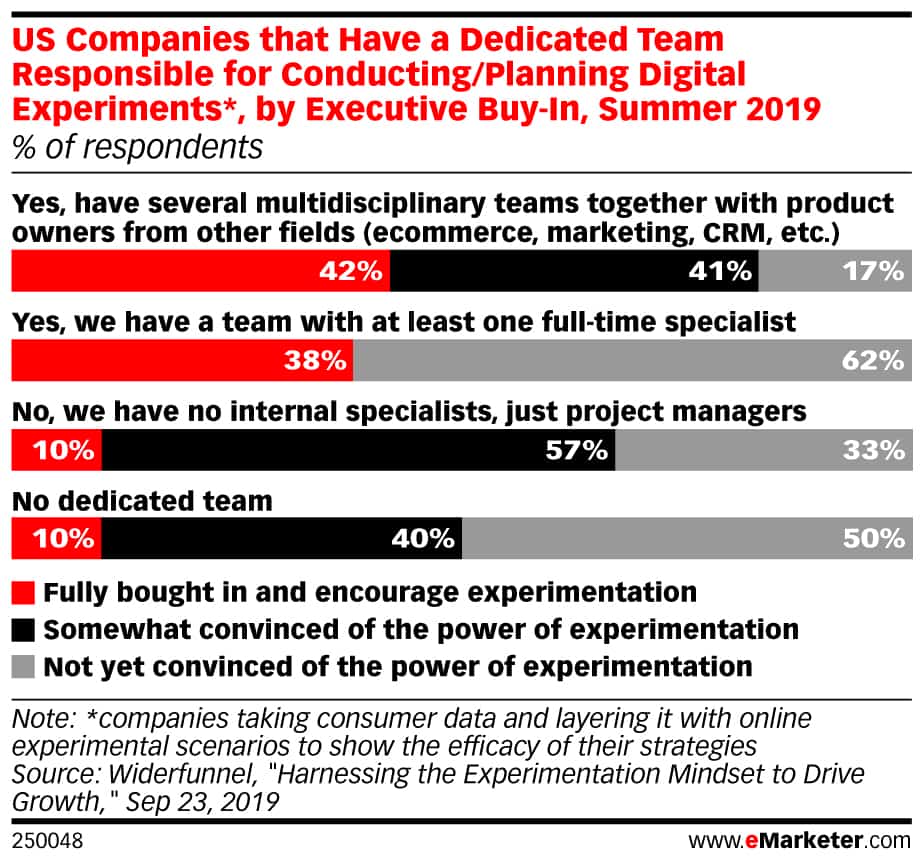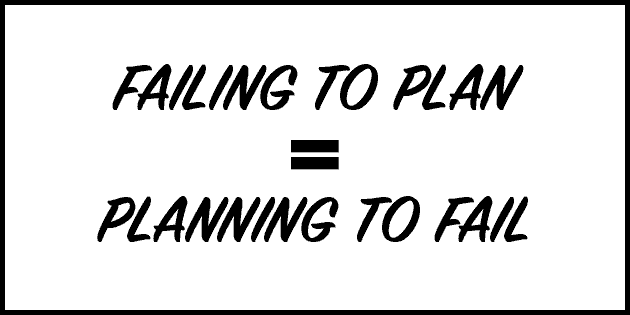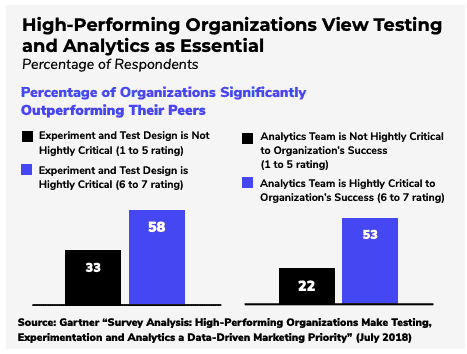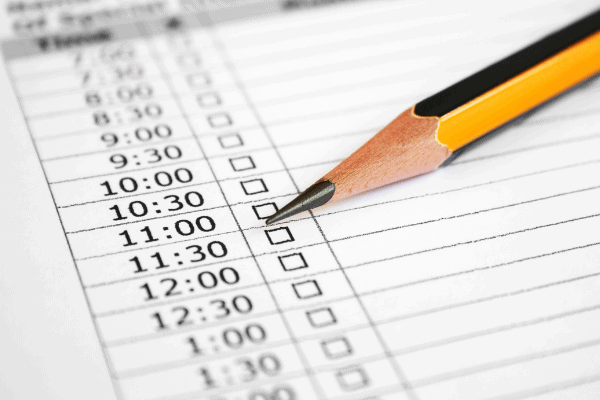Marketers have always relied on marketing experiments as part of their total measurement program. A/B and multivariate testing can help to answer specific questions related to optimizing advertising performance such as Which ad copy works best?, What version of the landing page should we use?, or Which channel works better to drive sales?
In the last few years, some of the industry’s key tracking mechanisms—third-party cookies and mobile ad IDs—are become less dependable due to policies and regulations being rolled out to protect consumer data privacy. In a cookieless world, marketing experiments are becoming more relied upon as a way to measure advertising effectiveness.
For marketing organizations looking to raise their game in terms of marketing experiments, the best way to do this is to facilitate a Test and Learn culture.
According to research from Gartner:
“Having a test-and-learn culture empowers your organization to make customer experience, marketing, and product decisions that cut through opinion, indecision, and uncertainty with data and insight. The results and outcomes mitigate the risk of making the wrong decisions, reduce or eliminate wasted efforts and resources, and improve revenue.”
What are some of the keys to building a best-in-class Test and Learn culture?
Five Tenets to a Successful Test and Learn Marketing Strategy

Brands looking to shore up their Test and Learn approach need to consider five key areas to run a successful Test and Learn program.
Test and Learn Marketing Strategy Tenet #1 – Training
Today’s marketers are expected to be data-driven, yet the vast majority of them don’t have the background or experience to be held to that standard. Colleges and universities still focus on the modern marketing basics like the funnel, the customer journey, and the four Ps (product, place, promotion, price). Meanwhile, true data skills beyond Excel report building are the norm.
Even experienced marketers may have some data skills related to their particular channel, but lack the foundation in this area to truly be called data-driven.
For brands that want their marketing team to be able to understand how to properly run data-driven experiments, they need to invest in training.
Test and Learn Marketing Strategy Tenet #2 – Tools
While the proper data training might be hard to find, the good news is that new innovation in Artificial Intelligence and machine-learning are helping to build marketing testing platforms that can take on much of the heavy lifting when it comes to data science. While in the past, methodologies such as incrementality testing were often complex, slow, and inexpensive, but today’s platforms can help to make it easier, faster, and less expensive.
Marketing technology vendors know that there’s a shortage of data scientists and are building the data heavy-lifting needs into their platforms so that everyday marketers can run sophisticated marketing experiments with ease. Brands that invest in these cutting-edge tools will be able to arm their Test and Learn teams with the right gear to reduce the time-to-insight and ensure the most accurate results.
Test and Learn Marketing Strategy Tenet #3 – Process
Investing in the proper Test and Learn tools is extremely important, but every marketer knows that the right tools aren’t enough to guarantee success. A team in transition needs a strong process to guide them and maintain efficiency.
Because Test and Learn is truly a team effort, marketing leaders must set goals and protocols for how to best leverage this valuable approach. What’s most important is understanding roles and responsibilities, especially during intense periods of change. Additionally, a process won’t be 100% right from the start—it will need to shift and adapt over time. Everyone involved needs to understand this from the start to avoid the frustration that can happen as everything keeps changing. Good processes are living, breathing things that can’t be rigidly maintained.
In a recent survey, companies who are dedicated to experimentation have strong processes, including fully defined roles and expectations. 
There’s an old adage: Failing to plan = planning to fail.

Any time there’s deep change—in a company, a family, a relationship, or even in one’s own life—change management is needed to support that transition. While most marketing organizations have been running experiments for years, the road to a more formal Test and Learn culture should not be underestimated.
Timelines need to be set. Expectations need to be reset. Scheduling those trainings, evaluating and investing in tools, and setting an effective process will take time. During that transition, people need clarity into these things. From top to bottom, a smooth transition will only happen if a solid change management plan is in place from the beginning.
Test and Learn Marketing Strategy Tenet #5 – The Organization
Ultimately, the success in building a Test and Learn marketing strategy will be tied to the organization. Leadership needs to be involved to hold people accountable to the change, get buy-in from groups around them, and positively reinforce the change being enforced.
This can’t just be about a small group of analysts. Test and Learn fundamentally changes a lot of things that marketers have grown accustomed to doing. For example, today’s measurement is more about launching a digital campaign and then optimizing it over time based on the attribution or channel metrics. Running marketing experiments before a campaign goes live to figure out the best creative, bids, and budgets takes patience and planning. Teams that are used to figuring it out as they go will need to be a bit more disciplined and focused to account for the time needed to run these tests. They might only take a few weeks, but for today’s digital marketers who aren’t used to working that way, it can be frustrating.
However, marketing leaders that stick to the plan, continue to remind their teams about the benefits of moving to Test and Learn, and—above all—preach patience during the adjustment will be able to successfully transition over to this needed method or working.
Organizations that significantly outperform their competitors are almost twice as likely to make testing and experimentation a marketing priority.

Is your marketing measurement approach ready for a cookieless future?
Remember, third-party cookies are basically going away and most measurement approaches rely on them. Moving to a Test and Learn marketing strategy won’t be easy, but there’s really no other option at this point. It’s a necessity for any brand that wants to understand the value of their marketing investments—which, of course, is every brand!
For more information on marketing experiments, download the Skai report, Marketing Experiments: How Leading Companies Make Data-Driven Decisions. In this complimentary white paper, learn how successful brands are prioritizing Test and Learn as the foundation of their marketing measurement practice to combat the impact of the new limitations of third-party cookies and mobile ad IDs.
For marketers already committed to Test and Learn and are looking for the best platform to help them run these experiments, Skai’s Impact Navigator is a best-in-class incrementality testing platform. For search marketers, Skai Experiments (part of Skai Search) enhances publisher experiment functionality with greater flexibility and more options than the free, native tools.
For more information on Impact Navigator or Skai Experiments, please reach out to schedule a quick demo to see these tools in action.






